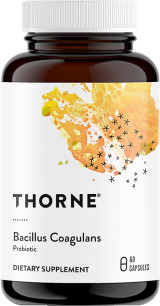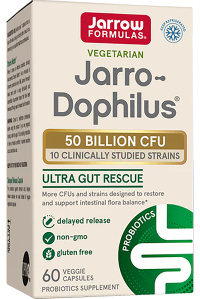
- 50 billion bacteria per capsule
- Contains 10 different strains

- Contains 30 billion bacteria per capsule
- Contains 8 different bacteria strains

- Contains 5 billion CFU Saccharomyces boulardii per capsule
- Sustained release

- Contains a minimum of 2 billion CFU Lactobacillus sporogenes
- Without additives that hinder absorption or cause allergies

- 5 billion bacteria per capsule
- Blend of L. Gasseri, B. Longum and B. Bifidum

- Contains 10 billion bacteria per capsule
- Contains 8 different bacteria strains

- Solgars most powerful bacterial formula
- 5 billion bacteria per capsule

- Speciaal for women
- Contains per capsule 10 billion bacteria from 6 different strains

- Combination of bacteria strains and prebiotics
- Contains 5 billion CFU Saccharomyces boulardii per capsule

- Contains 20 billion bacteria per capsule
- With NSF certification for (top) athletes

- Combination of bacteria strains and prebiotics (Inulin-FOS)
- 3.4 billion bacteria from 6 different strains

- Contains 10 billion bacteria per capsule
- Supplemented with prebiotic Inulin-FOS

- 55 billion bacteria per capsule
- Contains 10 different strains

- 25 billion bacteria per capsule
- Does not need to be refrigerated

- 15 billion bacteria per capsule
- Bacterial strains from specialist Chr. Hansen

- Highly dosed Lactobacillus rhamnosus
- Bacterial strains from specialist Chr. Hansen

- Contains 10 billion bacteria per capsule
- Does not need to be refrigerated

- Formula for digestion
- Contains 6 different enzymes

- 5 billion bacteria per capsule
- With 2.5 billion L. reuteri bacteria

- Contains 30 billion bacteria per capsule
- Broad spectrum with 17 different bacterial strains

- Mainly contains Saccharomyces boulardii (5 billion), one of the best strains studied
- Supplemented with prebiotic Inulin-FOS

- Contains 1.5 billion bacteria per capsule
- Five strains identified (genetic fingerprint check)

- Formula for digestion
- Contains patented bacteria blend enhanced with aloe vera and red elm

- Formula for the liver and digestion
- Contains a patented bacteria blend supplemented with artichoke and chicory

- 20 billion bacteria
- Supplemented with prebiotic Inulin-FOS

- High dose of prebiotics and bacteria strains of the LAB-4 complex
- Contains 500 mg FOS per capsule

- Blend of 25 high-quality ingredients
- Contains fiber, vitamins, enzymes and herbal extracts

- Broad spectrum with 17 different bacterial strains
- Well soluble powder

- 8 billion stomach acid and bile resistant bacterial spores of the strain Bacillus coagulans
- Stable long-lasting bacterial strain

- 3 billion bacteria per capsule
- Bacterial strains from specialist Chr. Hansen
If you are looking for a specific strain in specific quantities, see the list below or use the filters. If you are not sure which probiotic strain is best for you, contact us. Also, don't forget to use Prebiotics.
Lactobacillus

Miscellaneous
Jarro-Dophilus Probiotics
 Jarro-Dophilus Probiotics products from Jarrow contain a blend of popular and important probiotic strains, making them best suited for a general purpose.
Jarro-Dophilus Probiotics products from Jarrow contain a blend of popular and important probiotic strains, making them best suited for a general purpose.
The Jarro-Dophilus line consists of products that require refrigerated storage and products that stay good outside the refrigerator. We store the "refrigerated products" in our warehouse in a refrigerator and ship them with a cooling element or in a Coolbox.
Refrigerated products
10 strains, 50 billion bacteria: Jarro-Dophilus® Ultra
Non-refrigerated products
10 strains, 55 billion bacteria: Jarro-Dophilus EPS® Advanced 55 billion
8 strains, 25 billion bacteria: Jarro-Dophilus EPS® 25 billion
8 strains, 10 billion bacteria: Jarro-Dophilus EPS® 10 billion
About refrigeration and shelf life
Many Probiotics today are made so that they no longer need to be kept refrigerated. This has advantages and disadvantages.
The big advantage, of course, is that it does not have to be refrigerated. The disadvantage is that it requires additional substances and processing to protect the bacteria, and that usually has a significant impact on the price.
There are two times during the "life stage" of the product that refrigeration is an issue:
1. during transportation from the supplier in the US to the EU
2. during transport from the store to the customer
Not much can be done about problem 1. In principle, refrigerated shipping would be possible, but that increases the cost enormously (think possibly as much as 10 euros per jar).
Problem 2 is largely solved by Smeets & Graas by shipping the products with a cool pack and in insulating film.
This is not a 100% coverage solution because it sometimes takes longer for a product to be delivered and the outside temperature also plays a role. Thus, a package may arrive at the customer's door non-cool.
Solution for temporary non-cooling
Jarrow knows this problem and knows that it is basically impossible to solve. To prevent customers from receiving non-working products, another solution has been devised:
In production, many more Bacteria are put into a capsule than the label states (50 billion). The exact number varies by production batch but ranges from 100 to sometimes as much as 250 billion.
This means there is no problem with bacteria dying during a period of non-refrigeration. With these numbers, there will always be enough left, even at the end of a shelf life.
Lactobacillus bacteria
 Lactobacillus bacteria are naturally found in the human digestive tract and urinary tract. Foods that have been fermented, such as yogurt, contain these bacteria. The most well-known Lactobacillus bacteria are Lactobacillus acidophilus, Lactobacillus bulgaricus, Lactobacillus rhamnosus, Lactobacillus plantarum and Lactobacillus caseï.
Lactobacillus bacteria are naturally found in the human digestive tract and urinary tract. Foods that have been fermented, such as yogurt, contain these bacteria. The most well-known Lactobacillus bacteria are Lactobacillus acidophilus, Lactobacillus bulgaricus, Lactobacillus rhamnosus, Lactobacillus plantarum and Lactobacillus caseï.
Lactobacillus acidophilus
Lactobacillus acidophilus is often used in the preparation of some types of yogurt. The bacteria occur naturally in the mouth, gastrointestinal tract and vagina.
Lactobacillus rhamnosus
Lactobacillus rhamnosus GG (LGG) is a probiotic strain developed by Gorbach and Goldin (GG) that occupies a unique place among probiotics. Unlike many of the other strains, rhamnosus is the only strain that comes from the human gut and therefore not from cow's milk. The efficacy of Lactobacillus rhamnosus GG has been extensively studied.
Lactobacillus casei
Lactobacillus casei occurs naturally in the mouth and small intestine. Lactobacillus casei is one of the most widely used bacterial species as probiotics.
Lactobacillus helveticus
Lactobacillus helveticus is a strain very closely related to acidophilus. It is known through its use in that production of Swiss and Emmental cheese, as well as in various types of fermented milk types.
Lactobacillus jensenii
Lactobacillus jensenii is found in the vagina. Lactobacillus jensenii is about 20% of all vaginal microflora.
Bifidobacterium
Bifidobacteria is the most abundant bacteria in our intestines (90%). Already a few days after birth, our intestines are colonized by it. The most famous Bifidobacteria are Bifidobacterium bifidum, Bifidobacterium lactis, Bifidobacterium longum, Bifidobacterium thermophilum and Bifidobacterium pseudolongum.
Saccharomyces boulardii
This is also known as S. Boulardii, the only yeast probiotic.
